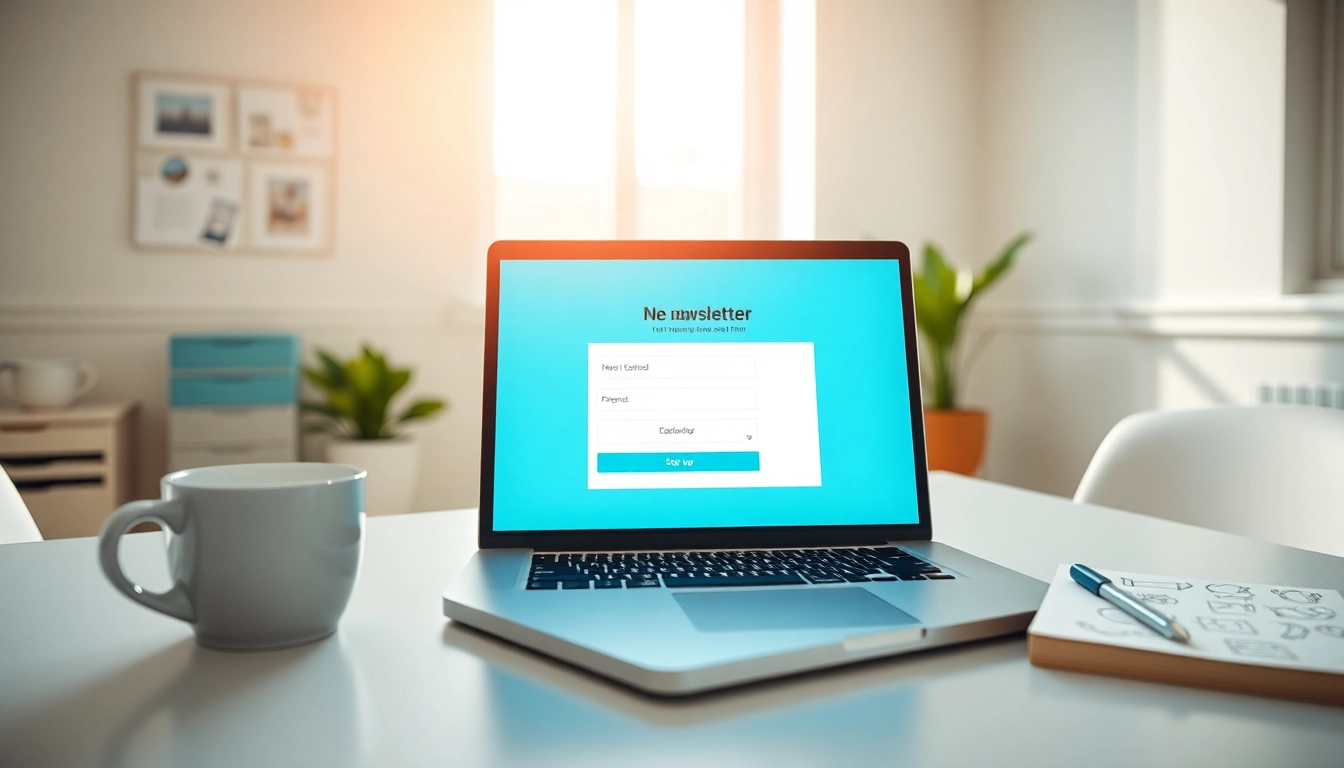Understanding the Importance of Newsletter Signup
In today’s hyper-connected digital landscape, effective communication is essential, and one of the most potent forms this takes is an email newsletter. A newsletter serves as a bridge between brands and their audience, fostering relationships built on trust, transparency, and engagement. As businesses seek innovative ways to engage their audience, the newsletter signup process stands out as a fundamental strategy for growth and retention in an increasingly competitive market.
What Makes Newsletter Signup Essential?
At its core, the newsletter signup is the gateway to a direct line of communication. With email marketing boasting an ROI that significantly surpasses other channels, obtaining permission to send newsletters allows brands to establish consistent contact with their audience. This element of consent is critical, as it signifies that recipients are genuinely interested in the content being provided, whether it’s updates, industry news, or exclusive offers.
Benefits of a Strong Mailing List
Building a substantial and engaged mailing list can yield numerous advantages:
- Direct connection: Email is a personal medium, allowing businesses to reach their customers directly in their inbox.
- Cost-effectiveness: Compared to traditional advertising, email marketing is relatively inexpensive, especially with a well-maintained list.
- Enhanced targeting: Segmenting your mailing list based on user preferences can lead to more tailored content, increasing engagement rates and conversions.
- Long-term relationship building: Consistent communication fosters trust and keeps your brand top-of-mind for your audience.
- Measurable results: Email marketing platforms provide robust analytics, allowing brands to monitor engagement levels and refine strategies accordingly.
Common Myths About Newsletter Signups
Despite the evident benefits, several misconceptions surrounding newsletter signups exist:
- People don’t want newsletters: While some may feel overwhelmed by emails, many people actively seek valuable information from brands they trust.
- All emails will be ignored: Writing compelling content and employing strategic segmentation can prevent your emails from being overlooked.
- Newsletters are only for big brands: Small and medium-sized enterprises can benefit immensely from email marketing, often seeing higher engagement rates.
- More subscribers equal more success: It’s essential to focus on quality over quantity; engaged subscribers are more valuable than a large, unresponsive list.
Best Practices for Designing Your Newsletter Signup Form
Key Elements of an Effective Signup Form
When designing your newsletter signup form, certain elements must be prioritized to maximize effectiveness:
- Simple design: The form should be easy to fill out, requesting only necessary information to avoid overwhelming potential subscribers.
- Strong call-to-action (CTA): Clear, action-oriented wording encourages users to sign up, such as “Join our community” or “Get exclusive updates.”
- Privacy assurance: Highlighting data protection policies can alleviate fears about sharing personal information.
- Responsive design: Ensure your signup form is mobile-friendly, as a significant portion of users accesses emails and websites via mobile devices.
Design Tips for Better User Engagement
Effective design can dramatically enhance user engagement:
- Use visuals: Incorporating images or icons can draw attention and make the form more inviting.
- Color psychology: Utilize colors that evoke trust and friendliness, aligning with your brand’s identity.
- Position strategically: Place the signup form in high-visibility areas, such as the homepage, blog posts, or footer sections.
- Incorporate testimonials: A brief quote from satisfied subscribers can establish credibility and encourage sign-up.
Example Analysis of Successful Forms
Analyzing well-performing signup forms can unveil several best practices:
- GetSiteControl: They showcased various newsletter signup forms across diverse industries, illustrating the importance of customization and context.
- Brevo: This platform emphasizes the importance of user incentives, highlighting how valuable offers lead to increased signup rates.
- Mailchimp: Known for their user-friendly forms, they integrate successful design principles that resonate across different audiences.
Incorporating Incentives for Increased Engagement
Types of Incentives That Work
Incentives can significantly enhance signup rates. Consider the following types:
- Exclusive content: Offering access to guides, eBooks, or webinars can be enticing.
- Discounts and promotions: Providing first-time subscribers with a discount can encourage immediate engagement.
- Free trials: Allowing users to test your product or service for free can convert signups into customers.
- Regular updates: Promise to keep subscribers informed about industry trends or news relevant to their interests.
How to Communicate Value Effectively
To make your incentive effective, you need to communicate its value clearly:
- Bullet points: Highlighting benefits in a concise format can capture attention quickly.
- Clear messaging: Use straightforward language to explain what subscribers will receive in return for signing up.
- Social proof: Mention how many people have already signed up or benefited from your newsletter, enhancing perceived value.
Case Studies on Incentive Success
Several brands have effectively implemented incentives to boost their mailing lists:
- Shopify: By offering free access to their eCommerce resources, they boosted their newsletter signups significantly.
- OptiMonk: They discovered that providing segmented content based on user interests led to higher engagement and improved open rates.
- The Guardian: By offering a variety of newsletters tailored to specific interests, they increased their subscriber base effectively.
Segmenting Your Audience for Better Results
Why Segmentation Matters in Newsletters
Audience segmentation is the practice of dividing your subscriber list into distinct groups based on shared characteristics:
- Personalization: Segmentation allows for tailored content, leading to increased engagement and relevance.
- Improved open rates: Targeting specific groups with tailored offers can enhance open rates significantly.
- Reduced unsubscribe rates: By delivering relevant content, you can decrease the likelihood of subscribers opting out.
Techniques for Effective Audience Segmentation
Several effective segmentation techniques can be employed to enhance your newsletter strategy:
- Demographics: Segmenting based on age, location, or gender can help tailor content to those specific audiences.
- Behavioral data: Analyzing user behavior, such as past purchases, can inform content personalization.
- Engagement levels: Tailoring messages to active versus inactive subscribers can help maintain overall list health.
Examples of Segmentation Success Stories
Many brands effectively utilize segmentation to enhance their email marketing:
- Amazon: Notorious for its use of behavioral data, they send tailored recommendations to increase conversion rates.
- Netflix: Customizes emails based on viewing habits to keep users engaged and returning for more content.
- Sephora: Uses demographic information to send targeted promotions to their audience, resulting in higher engagement rates.
Measuring the Success of Your Newsletter Signup Efforts
Key Metrics to Track Post-Signup
To evaluate the effectiveness of your newsletter signups, several metrics should be monitored:
- Open rates: The percentage of subscribers who open your emails indicates the relevance of your subject lines and overall strategy.
- Click-through rates (CTR): Measuring how many subscribers engage with links in your emails can reflect the quality of your content and offer.
- Conversion rates: Tracking how many subscribers complete desired actions, such as purchases, helps to gauge overall effectiveness.
- Unsubscribe rates: Monitoring the rate at which subscribers opt out can help identify content that may not be meeting their expectations.
Tools for Analyzing Signup Performance
Using robust analytics tools can facilitate the measurement of your email marketing efforts:
- Google Analytics: Track user behavior on your site to see how email traffic performs compared to other channels.
- Email service providers (e.g., Mailchimp, Constant Contact): Most provide built-in reporting features to help track engagement metrics.
- A/B testing tools: Experiment with various subject lines and content strategies to identify what resonates best with your audience.
Tweaking Your Strategy for Continuous Improvement
Adapting your email marketing strategy based on performance metrics is essential for ongoing success:
- Regularly update content: Refresh your newsletter content based on changing trends, feedback, and engagement metrics.
- Solicit feedback: Encourage subscribers to provide input on what content they find valuable, allowing for more targeted offerings.
- Review segmentation regularly: Redefine segments based on changing behaviors and trends within your audience.



